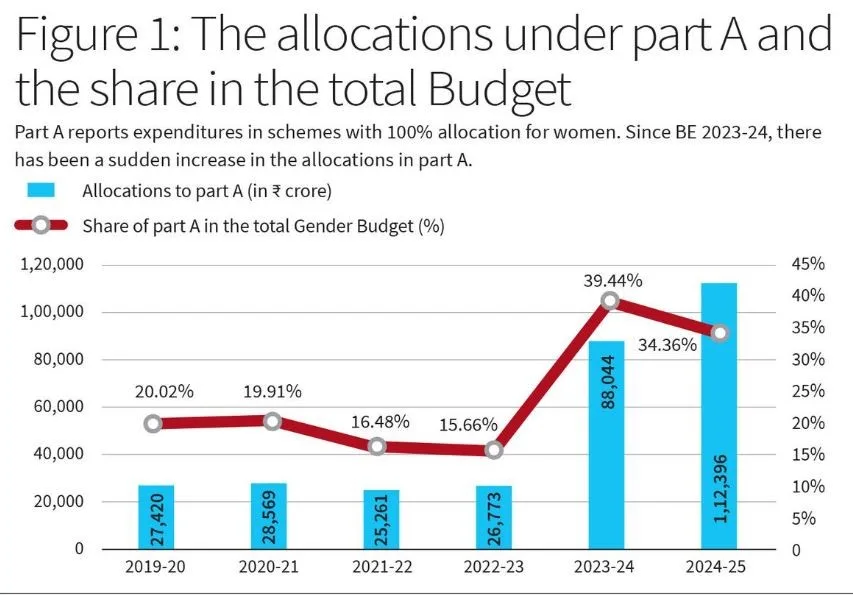Syllabus: GS2/Governance
Context
- The Gender Budget reached 1% of GDP estimates in 2024-25 for the first time.
About
- Women-led development remains at the core of announcements made by the Finance Minister (FM) in this year’s Budget.
- Overall allocations currently stand at more than ₹3 lakh crore for pro-women programmes.
- There has been a remarkable 218.8 percent rise in the budget allocation for women’s welfare from FY14 to FY25.
What is Gender Budgeting?
- Gender budgeting is a strategy that includes gender considerations in the budgeting process.
- It was first introduced in 2005-06.
- It involves analysing and allocating budget resources in a way that addresses the specific needs and priorities of women and girls and promotes gender-sensitive policies and programs.
Gender Budget 2023-24
- The previous Gender Budgets consistently reported an average share of 5% of the total budgetary allocations.
- This year the share of allocations to pro-women schemes stands at approximately 6.8% of the total budget expenditure for 2024-25, which is way above the usual trends.
- The Gender Budget is divided into three parts.
- While Part A covers schemes with 100% provision for women, Part B includes schemes with 30-99% allocations for women.
- For the first time ever, Part C includes schemes with allocations of up to 30% for women.

Significance
- The Economic Survey highlights the importance of women-led development, starting with the health and education of the girl child.
- Key indicators show progress in this area, with the national sex ratio at birth (SRB) improving from 918 to 930, and the maternal mortality rate decreasing from 130 to 97 per lakh live births.
- Women’s participation in skill development has increased.
- Under the Pradhan Mantri Kaushal Vikas Yojana (PMKVY), it grew from 42.7 per cent in FY16 to 52.3 per cent in FY24.
- The Jan Shikshan Sansthan (JSS) Scheme has 82 percent female beneficiaries.
- Women’s involvement in Industrial Training Institutes (ITIs) and National Skill Training Institutes (NSTIs) rose from 9.8 per cent in FY16 to 13.3 percent in FY24.
- In the National Apprenticeship Promotion Scheme (NAPS), it went up from 7.7 percent in FY17 to 20.8 per cent in FY24.
Government initiatives
- Mission Shakti is a women empowerment programme launched by the Ministry of Women and Child Development (MWCD) for the period 2021-2025.
- It aims to strengthen interventions for women’s welfare, safety, and empowerment, making women equal partners in nation-building.
- Initiatives like Beti Bachao, Beti Padhao, Sukanya Samriddhi Yojana, Janani Shishu Suraksha Karyakram, and PM Matru Vandana Yojana have also contributed to significant improvements in the welfare and empowerment of women and girls.
- The Mission Saksham Anganwadi and Poshan 2.0 programmes focus on improving women’s health beyond just calorie intake and improving overall health and immunity with proper micronutrients.
- The Women in Science and Engineering-KIRAN (WISE KIRAN) program has supported nearly 1,962 women scientists from 2018 to 2023.
Conclusion
- Incorporating explanations for allocations in GBS would not only ensure accounting accuracy but will help in gender audits and provide pathways for improved gender outcomes in government programmes.
- Several years of advocating for improved reporting in the GBS by experts is reflected in the inclusion of a third part.
- Gender responsive budgeting is a powerful tool to close the gender gaps in an economy.
Source: TH
Previous article
News In Short – 29-08-2024